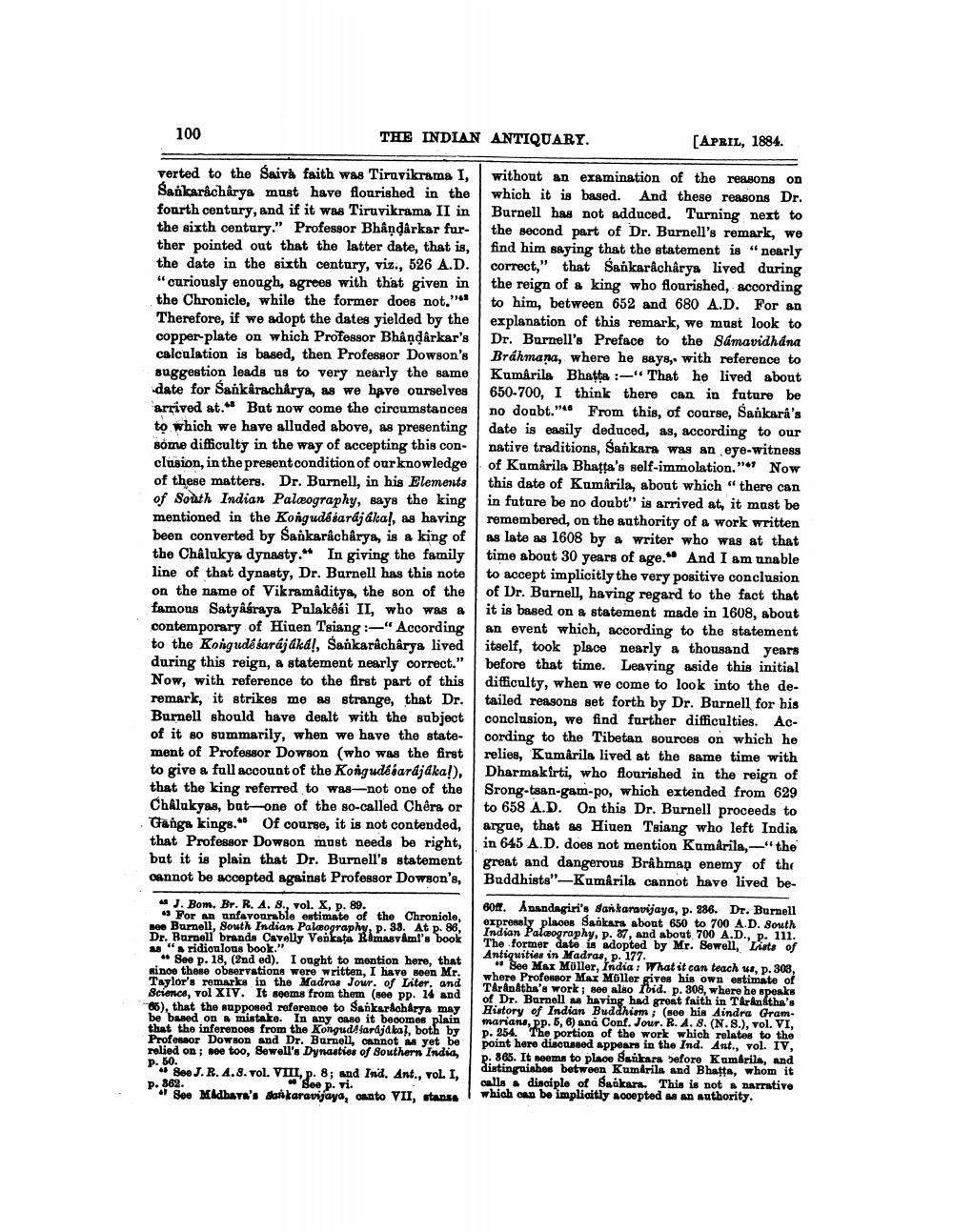________________
100
THE INDIAN ANTIQUARY.
[APRIL, 1884.
verted to the Saiva faith was Tiruvikrama I, without an examination of the reasons on Sankaracharya must have flourished in the which it is based. And these reasons Dr. fourth century, and if it was Tiruvikrama II in Burnell has not adduced. Turning next to the sixth century." Professor Bhåndarkar fur- the second part of Dr. Burnell's remark, we ther pointed out that the latter date, that is, find him saying that the statement is "nearly the date in the sixth century, viz., 526 A.D. correct," that Sankaracharys lived during "curiously enough, agrees with that given in the reign of a king who flourished, according the Chronicle, while the former does not." to him, between 652 and 680 A.D. For an Therefore, if we adopt the dates yielded by the explanation of this remark, we must look to copper-plato on which Professor Bhandarkar's Dr. Burnell's Preface to the Samavidhdna calcolation is based, then Professor Dowson's Brahmana, where he says. with reference to suggestion leads us to very nearly the same Kumârila Bhatta :-"That he lived about date for Sankaracharya, as we have ourselves 650-700, I think there can in future be arrived at. But now come the circumstances no doubt." From this, of course, Sankara's to which we have alluded above, as presenting date is easily deduced, as, according to our some difficulty in the way of accepting this con- native traditions, Sankara was an eye-witness clusion, in the present condition of our knowledge of Kumarila Bhatta's self-immolation."" Now of these matters. Dr. Burnell, in his Elements this date of Kumârila, about which "there can of South Indian Palæography, says the king in future be no doubt" is arrived at, it must be mentioned in the Kongudósarájákal, as having remembered, on the authority of a work written been converted by Sankaracharya, is a king of as late as 1608 by & writer who was at that the Châlukya dynasty." In giving the family time about 30 years of age." And I am unable line of that dynasty, Dr. Burnell has this note to accept implicitly the very positive conclusion on the name of Vikramaditya, the son of the of Dr. Burnell, having regard to the fact that famous Satyasraya Pulakosi II, who was a it is based on a statement made in 1608, about contemporary of Hiuen Tsiang :-"According | an event which, according to the statement to the Konguedo sarájaká!, Sankaracharya lived itself, took place nearly a thousand years during this reign, a statement nearly correct." before that time. Leaving aside this initial Now, with reference to the first part of this difficulty, when we come to look into the de. remark, it strikes me as strange, that Dr. tailed reasons set forth by Dr. Burnell for his Burnell should have dealt with the subject conclusion, we find further difficulties. Acof it so summarily, when we have the state- cording to the Tibetan sources on which he ment of Professor Dowson (who was the first relies, Kumârila lived at the same time with to give a full account of the Kongudésardjaka!), Dharmakirti, who flourished in the reign of that the king referred to was-not one of the Srong-tsan-gam-po, which extended from 629 Chalukyas, but one of the so-called Chêra or to 658 A.D. On this Dr. Burnell proceeds to Ganga kings. Of course, it is not contended, argue, that as Hiuen Tsiang who left India that Professor Dowson must needs be right, in 645 A.D. does not mention Kumarila, -"the but it is plain that Dr. Burnell's statement great and dangerous Brahmap enemy of th cannot be accepted against Professor Dowson's, Buddhists"-Kumkrila cannot have lived beJ. Bom. Br. R. A. 8., vol. X, p. 89.
604. Anandagiri's Sankaravijaya, p. 386. Dr. Burnell 45 For an unfavourable estimate of the Chroniolo. neo Burnell, South Indian Palæography, p. 38. At p. 86,
expressly places Sarkars about 650 to 700 A.D. South
Indian Palæography, P. 87, and about 700 A.D., p. 111. Dr. Burnell brands Cavelly Venkata Rimasymi's book M" ridionlous book."
The former date is adopted by Mr. Sewell, Lists of
Antiquities in Madras, p. 177. - See p. 18, (and ed). I onght to mention here, that Rince these observations were written, I have seen Mr.
* See Mar Müller, India : What it can teach us, p. 303, Taylor's remarks in the Madras Jour, of Liter, and
where Professor Max Möller gives his own estimate of
Taranatha's work; see also toid. p. 308, where he speaks Science, vol XIV. It seems from them (see pp. 14 and
of Dr. Burnell as having had great faith in Tiranatha's 88), that the supposed reference to Sankardoharya may History of Indian Buddhism ; (see his Aindra Grambe based on a mistake. In any case it becomes plain marians, pp. 5, 6) sná Conf. Jour. R.A. 8. (N. S.), vol. VI, that the inferences from the Kongud/farajdkal, both by P. 254. The portion of the work which relates to the Professor Dowson and Dr. Burnell, cannot as yet be point here discussed appears in the Ind. Ant., vol. IV, relied on ; noe too, Sewell's Dynasties of Southern India, p. 865. It seems to place Bankara before Kumbrils, and " See J.R. 4.8. vol. VIII, p. 8; and Ind. Ant., vol. I,
distinguishes between Kumirila and Bhatta, whom it P. 862.
Gulls dinciple of Sankara. This is not a narrative *** See MAdhara's Sarkaravijaya, canto VII, sanes which can be implicitly accepted as an authority.
P. 30.
See p. vi.




